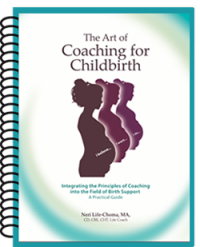
Why Transformational Coaching is Essential to the Vaginal Birth Initiative
As a seasoned birth support professional, I have witnessed the maternal care system implementing so many new procedures and clinical policies over the 23 years that I’ve practiced. Since 2010, new reforms in maternal care associate the quality and safety of care with the increase in vaginal birth rates and the reduction in cesarean rates. However, the origins of obstetric gynecology lead maternal care policymakers to search for new clinical reforms to resolve a problem that may have originated somewhere else. I believe that none of these reforms will be able to achieve the three major principles designing safety of care: patient- engagement, patient-centered care, and partnership among patients, their family members, and their medical caregivers.
The Vaginal Birth Initiative (VBI): the new safety code in L&D
The Vaginal Birth Initiative has been a significant focus in maternal care and guided the new reforms. This recent focus is quite a paradigm shift in obstetrics. Historically, maternal care was founded based on fear: fear of maternal death, fetal death, and fear of labor pain – the latter of which male doctors were confusing with pathogenic pain. Obstetrics’ main goal was saving birth givers’ and newborns’ lives, and alleviating pain. Therefore, little attention, if any, was given to birth givers’ experiences or to the pathway by which death and pain were prevented.
Obstetrics main goal was saving birth givers’ and newborns’ lives, and alleviating pain
In efforts to achieve the Vaginal Birth Initiative, almost every state in the US now has its own Perinatal Quality Collaborative, responsible for achieving these new goals. However, a closer look at ACOG’s guidelines and the strategies recommended by states’ maternal care collaboratives reveal that they try to achieve the quality and safety of maternal care employing new clinical reforms. The guidelines call for clinical culture change, standardization of induction and labor support, and developing standardized protocols for identification and response to labor challenges/abnormalities.
Principles for achieving Safety of Care in general healthcare
I honestly doubt that the standardization of care and the clinical changes are what’s needed to increase vaginal birth rates and the safety of care. My understanding is that reforms and changes toward achieving these desired results are not clinical, and I find support for my stand in the 2017 Guide to Patient and Family Engagement in Hospital Quality and Safety.
Since 2010, new reforms in maternal care associate the quality and safety of care with the VBI and a reduction in cesareans
This guide suggests that patient-engagement, patient-centered care, and partnership among patients, their family members, and their medical caregivers are the three leading principles of safety of care and patients’ satisfaction in general healthcare. I can think of many reasons for these principles to be the ones leading the safety in maternal care, i.e the desired increase in vaginal births. If anything, these principles should be more central in maternal care than in general healthcare, taking the variability and unpredictability of normal birth.
Can we carry out the VBI through Transformational Coaching?
Labor and Delivery nurses are required to complete many CE units, yearly, in order to renew their license. A quick look at the required CEs shows that all of them teach clinical skills: CPR, NPR, AP testing, triage, EFM concepts, High-Risk, NICU review, and more alike. However, the three principles of safety and quality of care have nothing to do with clinical skills or policies and can all be achieved by teaching and implementing inter-personal skills and strategies used by professional coaches in a variety of fields. Trained coaches work with strategies that lead their clients to achieve clarity about their personal goals, beliefs, and motivation for their goals. Coaches lead their clients to engage in actions that will lead them closer to achieving their desired outcomes. Coaches hold their clients accountable for their process. The coaching relationships are a partnership built around the clients’ goals and reality since coaches see the clients as experts in their own lives.
L&D nurses can be trained to practice medicine from a coaching position. Learn how
As a transformational coach that practices birth support, I teach L&D nurses to practice medicine from a coaching position. This position begins with nurses assuming the patients’ competency; their bodies’ competencies. It goes through giving-up on the authoritative position as an expert and seeing their patients’ as experts in their own lives. I train nurses with coaching strategies that enable them to establish partnerships with their patients and lead towards a patients’ engagement and accountability for their healthy vaginal process. Only then, L&D nurses can engage their patients with the wealth of labor support and comfort measures that I teach them and help their patients trust those traditional maternal care techniques.
Reconnecting L&D nurses with their passion and motivation is a joy
This position can be freeing! Instead of bearing so much responsibility for patients’ satisfying birth experience, nurses can share it with their patients, and the patients’ support group. When nurses learn to master communication skills and learn to make rapport in just a few minutes, they will practice with joy. They will reconnect with their motivation to become nurses. When nurses connect and engage their patients they actually provide safer care. This acknowledgment is profoundly motivating to integrate these new coaching strategies. I invite you to visit the Birth Coach Method nurses’ portal to learn more about our virtual and in-person contact hours.
- Overshadowing the Transformative Essence of Childbirth with Data - July 10, 2024
- Navigating the Epidural Dilemma - May 28, 2024
- Informed Decision in Birth Support: A Myth of Empowerment? - April 29, 2024
hospital birth, medical interventions in childbirth, obstetric nursing


